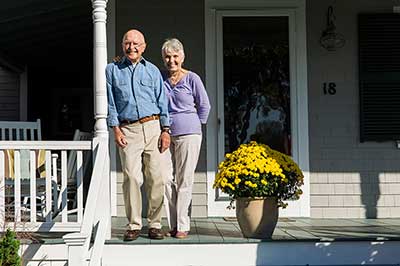Last updated May 2022
Although in contemporary America seniors are less likely to live with their children, compared to other parts of the world, AARP’s 2021 “Home and Community Preferences Survey” found that 52 percent of U.S. adults live in multigenerational households. AARP reported that “among those polled, 40 percent said they care for someone living in their home and 38 percent look after someone living on their own. Of those, nearly half worried about the ability of the person they care for to continue living independently.”
Even if you have children or other relatives who can help you out, a key part of aging in place involves setting up a support system for your social, personal, and medical needs. Think of this as creating a stand-in family.
 That’s where elder villages come in. These are usually neighborhood-focused networks that offer social, medical, and household resources (usually from volunteers) that can help you stay in place.
That’s where elder villages come in. These are usually neighborhood-focused networks that offer social, medical, and household resources (usually from volunteers) that can help you stay in place.
In 2001 a handful of older residents of Boston’s Beacon Hill neighborhood became concerned about how they would stay in their neighborhood and their homes into their 80s and 90s. This led to the founding of the country’s first elder village, Beacon Hill Village, a volunteer neighborhood group designed to provide social connections and practical assistance to older adults. There are now hundreds of these villages in the U.S., with many more in development. Some cover entire counties; others focus on small, often walkable neighborhoods.
Each village offers a range of services and benefits, from finding teenagers to play chess with residents to helping with grocery shopping. Typically, a small tax-deductible fee (usually $100 to $500 a year, with many villages offering scholarships for lower-income residents) lets members take advantage of benefits like rides to medical appointments, dog-walking, yardwork, home fix-ups, and tech assistance. The most active villages also offer social activities like book clubs and walking groups.
If there’s no village in your area, you can help found one. You’ll need to:
- Organize a group of nearby neighbors interested in staying in their homes.
- You can learn about the village model and get referrals to other resources at the Village to Village Network website. You can sign up for a 12-month “Opportunity Member Trial Membership” for $175, with access to its library of documents, webinars, toolkits, and other resources. (Regular memberships cost $200 to $425/year per village, depending on size and model.)
- Decide on a geographic area you’d like to cover. Many active villages serve smaller walkable neighborhoods; some encompass whole counties.
- To avoid duplicating services already offered for free or almost free by local governments, talk to local councils or agencies on aging. Also find out if your local aging agencies have policies or programs to encourage village-forming.
- Evaluate whether you’d like to operate the village as a primarily volunteer operation (lower operating costs and membership fees) or a staffed organization. Volunteer villages often grow into staffed villages as membership increases.
- Can you establish a brick-and-mortar headquarters, or do you want to run the village remotely? Both have advantages and disadvantages. Having a physical location often benefits members, but it can be expensive.


